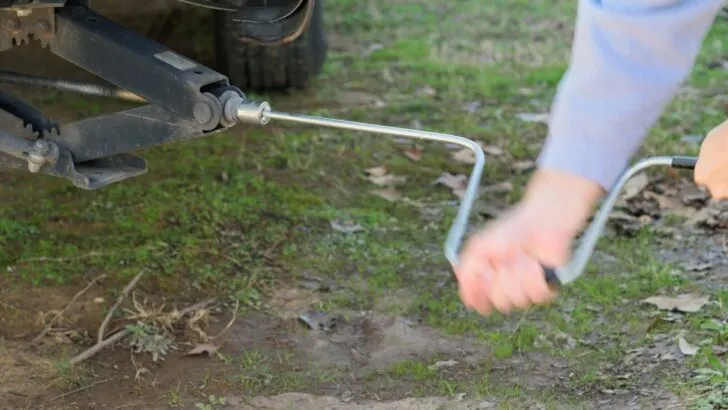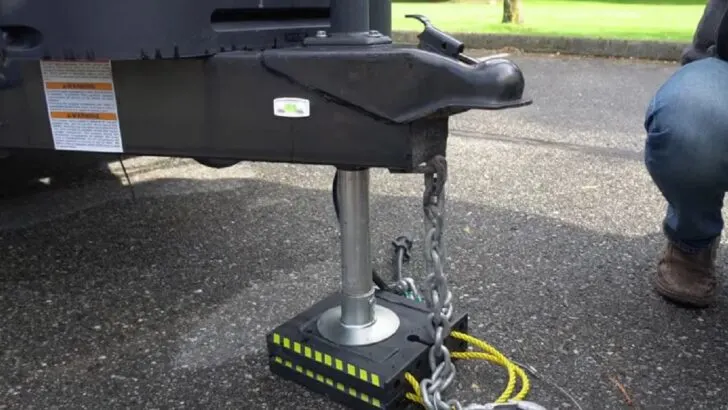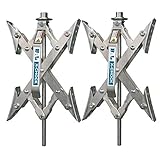It doesn’t take long for an RVing newbie to realize how important stabilizing an RV is! A few hours into the first camping trip, when the occupants of the rig are getting that seasick feeling every time someone walks around, it becomes crystal clear that something needs to be done to stabilize the camper and make it as steady as possible.
Stopping that side-to-side movement is key. There are a number of ways to accomplish this, and that’s what this post is all about.
- 1) What’s the Difference Between Leveling and Stabilizing an RV?
- 2) What Are Stabilizer Jacks?
- 3) How Do You Stabilize an RV?
- 4) Types of RV Stabilizers
- 5) How Do You Keep Your RV Stabilized to Prevent Sway?
- 6) Free RVing Tips, Tricks, Reviews, Giveaways & More
What’s the Difference Between Leveling and Stabilizing an RV?
We’ve made several YouTube videos, and have written several posts, over the years about leveling an RV. You may have seen us gushing about our LevelMatePro RV leveling system or even discussing the importance of good RV jack pads.
But leveling and stabilizing an RV are two different things.
With leveling, you’re using jacks or leveling blocks to lift one or more sides of the rig to get it level (or as close to level as possible).
Stabilizing means adding stability to the RV. Not lifting it.
You can have a perfectly level RV that sways like crazy when anyone walks inside the rig or even when the wind blows.
This is because, without stabilizers, the RV is just sitting on its axles and suspension. The trouble with this is that the axles and suspension are designed to allow the RV to move so that bumps and dips in the road don’t get directly transmitted to the RV.
So regardless of how level your rig is, without stabilizers, it’s just sitting on the suspension, and the body of the RV can still move. Deploying stabilizers helps to eliminate that movement.
What Are Stabilizer Jacks?
This is an important question because many people are confused by the purpose and function of stabilizer jacks, thinking they’re for levelling the RV.
But stabilizer jacks aren’t strong enough to lift and support the full weight required to do that. They’re designed instead to provide additional “stiffening” spots, usually at the corners of the rig, so that it doesn’t rock or sway when people move around inside or if the winds pick up.
Often stabilizing jacks look like the scissor jack you’ll find in your car for replacing a flat tire.

Many people mistakenly believe that these scissor-like stabilizer jacks are for leveling an RV. Not so! Their purpose is actually to stabilize an RV.
Stabilizer jacks are more commonly found on towables (travel trailers & fifth wheels), but can also be found on smaller motorized RVs.
Pro Tip: If you’ve got a manual stabilizer jack like the one shown in the photo above that uses a removable handle to rotate a bolt that extends the stabilizers, use a cordless drill (with the correct size socket) instead of using the provided handle. This works well both for extending and retracting manual stabilizer jacks and makes the task so much faster and easier.
Just be careful not to get carried away when extending them because again, stabilizers are designed to help stop motion in the RV, not to get it level.
Note that not all stabilizing jacks are manually operated. There are also electrically-powered stabilizers that deploy with the push of a button… no cranking or cordless drill required.
Let’s take a look at the entire process of stabilizing an RV.
How Do You Stabilize an RV?
Now that we know the difference between leveling and stabilizing, let’s talk about what needs to happen for an RV to stop swaying and become (mostly) rock-solid and stable.
Technically, in order to fully stabilize an RV, there are three issues you’ll want to tend to that cause movement of the RV.
Up-and-Down Motion
Leveling jacks handle the up-and-down motion of the RV.
This, of course, is part of the leveling process. As you’re leveling your rig (either with your auto-leveling system or with the landing gear or power jacks), you’re leveling the RV and stabilizing the up-and-down motion.
We should note here that tongue jacks, sometimes referred to as “trailer jacks” or “hitch jacks”, raise and help stabilize a trailer or fifth wheel (and also bring it to the appropriate level for attaching it to a tow vehicle).
A couple of high-quality utility blocks are perfect additional stability when placed under the tongue jack.

A couple of Utility Blocks placed under the tongue jack of a travel trailer not only serve to level the front of the trailer but also serve as a stabilizing force.
Pick up a set of Utility Blocks on Amazon:
Incidentally, there are also RV step stabilizers that can be helpful. These can be added beneath your RV steps and adjusted to the proper height to touch the ground, adding stability to your RV steps as you walk up and down them.
- MORE STABILITY — This stabilizer gives you the ground support you need to eliminate unwanted bounce and instability when going in and out of your RV
- PROTECTION — The Solid Stance even helps protect your bottom entry step from wear and sagging
Side-to-Side Motion
As discussed earlier in the post, side-to-side motion is addressed by deploying your RV stabilizing jacks. It’s their primary function!
Back-and-Forth Motion
Wheel chocks handle back-and-forth motion (and are especially useful for parking on slopes). In addition to helping stop motion, chocking your RVs wheels is a safety move.
Safety Tip: Once you’ve leveled your travel trailer, always chock the tires before unhitching it from your tow vehicle.
Wheel chocks are inexpensive but important pieces of RV gear.
- Item Package Dimension: 9.99L x 8.49W x 5.19H inches
- Item Package Weight - 1.75 Pounds
Types of RV Stabilizers
There are several different types of RV stabilizers. The type of stabilizer that works best for your RV will depend on the type of RV you have. In fact, many motorhomes, travel trailers, and 5th wheels have built-in stabilizers that are deployed either automatically or manually.
Even so, some rigs need more stabilization than others and may require additional stabilizers. Let’s take a look at a few different options and how they work to help stop the sway!
Jack Stands
Jack stands are positioned under the RV and then raised to the appropriate height to maintain/improve the stability of the rig.
Camco Olympian Aluminum Stack Jacks
Camco’s Stack Jacks are made of cast aluminum and can support up to 6,000 lb. each. They’re adjustable from 11″ to 17″.
Here’s an example. This is a pack of four Stack Jack jack stands:
- UNMATCHED RV STABILITY: Stabilize your RV with Camco's Aluminum Jack Stands for unmatched steadiness! This durable camper accessory prevents wobbling,...
- FAST, SIMPLE SETUP: Streamline RV leveling and stabilization effortlessly. Level your trailer, then place the jacks under your vehicle & adjust the...
Tripod Stabilizer
These stabilizers are for 5th wheels and can be used on any 5th wheel with a kingpin. As the name would suggest, it’s designed like a tripod with three legs holding the center piece.
Here’s an example:
Camco Eaz-Lift 5th Wheel King Pin Tripod Stabilizer
This type of RV stabilizer supports the front of the 5th wheel and keeps it from moving both front-to-back and side-to-side.
With this stabilizer, you’d move the foot pads in or out as needed and make other adjustments using the adjustment lever and leveling screw. The height of this particular stabilizer can be adjusted from 39″ to 53″.
- 5TH WHEEL TRIPOD STABILIZER: Camco’s Eaz-Lift RV fifth Wheel Stabilizer offers the ultimate stability and support for your fifth wheel trailer. It...
- COMPATIBILITY: This fifth wheel tripod stabilizer is specifically designed for use with fifth wheel trailers.
Long RV Stabilizers
This type of RV stabilizer can be used either on the front and rear of the RV or on both sides of the rig to add stability while you’re living in your RV.
There are manual stabilizers of this type that need to be installed by hand each time you use them, and there are also electric stabilizers of this type that extend with the push of a button.
Here are examples of each type:
Valterra RV Stabilizer
These RV stabilizers are adjustable for any RV with a clearance of 14″ to 28″ from frame to ground.
This stabilizer is compatible with 5th wheels, Class C RVs, toy haulers, travel trailers, and utility trailers.
Each stabilizer comes with a storage bag and folds down compactly.
- Folds for easy storage
- Using two--front and rear or on both sides--makes RV rock solid
Lippert Components PSX1 High-Speed Power Stabilizer Jack
This heavy-duty, waterproof stabilizer jack has a 30″ lift range and a power switch for automatic stabilization.
No cranking, just the flip of a switch, and your stabilizing jack is set up and ready to keep your rig steady.
Each leg operates independently for accurate deployment on uneven terrain, and the PSX1 is compatible with most RVs.
- POWERFULLY DESIGNED — No more cranking. With the PSX1, campers can stop wasting time and energy with manual cranks. A flip of a switch is all it...
- RUGGED VERSATILITY — We designed our stabilization system to automatically adjust to uneven, rugged terrain. Each leg operates independently,...
Slide-Out Stabilizers
There are also stabilizers that can be jacked in place underneath slide-outs to help keep them stable (and properly sealed). Just be aware that many manufacturers recommend against using them; if you ignore that, it could void your warranty (if it’s still valid).
But, even if slide-out stabilizers aren’t prohibited by your manufacturer, they should never be used to lift or level the rig or slide. Only apply enough upward pressure to prevent the slide from sagging while walking around inside the RV.
With all of that said, here’s an example:
Camco Eaz-Lift RV Slide-Out Supports
These slide stabilizers are height adjustable from 19″ to 47″ and support up to 5,000 pounds each.
They come as a set of two and help stabilize your RV’s slide-out room and protect the slide mechanism.
This particular pair fits up to a 5 1/2″ slide-out rail.
- PROTECTS SLIDE-OUT MECHANISM: These supports provide added stability for extended slide-outs. Keep your slide-out level and stop sagging or bending of...
- ADJUSTABLE HEIGHT: Easily adjust from 19″ (collapsed) to 47″ (extended), with incremental locked positions. The tethered pin makes height...
Scissor Wheel Chocks (or X-Chocks)
Scissor Wheel Chocks (also known as X-Chocks due to a popular brand from BAL) are devices that can be used on RVs that have dual axles. They have limited benefits for motorhomes, though, since (1) they’ll only work for motorhomes with a tag axle, and (2) the parking brakes on motorhomes (combined with a wheel chock) effectively provide the same benefit. But, they are commonly used on (and quite helpful for) travel trailers and fifth wheels.
The reason they’re only useful for dual-axle RVs is that they use a scissor mechanism to pressure-fit themselves between two tires on the same side of the RV (impossible for a single-axle unit). This locks the two wheels together, helping to minimize (or even eliminate) the rocking & swaying you can feel due to the tires rolling as you move around in the RV (see the comments below for some of our readers’ experiences).
BAL X-Chocks
This set of X-Chock brand scissor chocks is extremely popular! They retract down to as little as 1 3/8” wide to fit between the tires of your RV’s axles but can extend to 10” to span the most common gap.
With a durable rust-inhibitive coating, they’ll last for years to come. And they come with their own plated ratchet wrench for extending/retracting them.
- Provides added stabilization and prevents tire shifts by applying opposing force to tandem tire applications
- As opposed to other chocks, the X-Chock works with the tires’ natural movement instead of against them
PRO TIP: use a cordless drill* (like our favorite 20V DeWalt ) to quickly turn the screw drive that extends/retracts the scissor mechanism… which also works great for your standard trailer stabilizer legs. Get set up at your new campsite in no time!
*Be sure that you’re using a standard cordless drill/driver, and NOT an impact/hammer driver, as the hammering action can damage the scissor mechanisms.
How Do You Keep Your RV Stabilized to Prevent Sway?
We’d be interested to know what your preferred method is for stabilizing your RV and preventing the seasick feeling that comes from an unstable rig.
Drop us a comment and let us know what works well for you!
Free RVing Tips, Tricks, Reviews, Giveaways & More
Subscribe to our daily newsletter! We’ve been full-time RVers for 20 years (!) and share everything we’ve learned about RVing in our daily blog posts. Join our online community to receive a wealth of great RVing knowledge delivered right to your inbox.
Whether this is your first time on the road or you’re a seasoned full-timer, you’ll love the wide range of RVing topics we cover. Don’t miss a single article or any of our famous RV gear Giveaways — Subscribe today!











Warren G
Tuesday 26th of December 2023
Although it doesn’t eliminate movement entirely, the X-chocks we use on our TT help a lot.
Jim
Friday 30th of December 2022
We found that using a pair of X Chocks on our 2-axle travel trailer is much more stable than tire chocks. Also, the tongue and scissor jacks are more stable the less they are extended. Even on a level RV pad we use a short stack of leveling blocks under each.
TheRVgeeks
Friday 30th of December 2022
Hey Jim. Jacks/stabilizers being more stable the less they're extended/deployed is true across ALL RVs. Good reminder!
mot
Tuesday 27th of December 2022
After having our rig lifted up by Wyoming winds in rock springs, then dropping down to bend a lipert electric power stabilizer there had to be a stable solution. Took 4 2x4 from the lumber yard scrap box cit to 30". Installed 1 i bolt in each about 1' from the end of each. Place in the point where the frame & a support come together @ each end of the rig. Using a ratchet strap the eyebolts to pull the bottom ot the legs together. We've now been in 60-80 kt. Croswinds & nothing rocks in winds or walking.
John
Tuesday 27th of December 2022
Thank you for this article. We own a Thor Quantum with one slide out (purchased from daughter number 4). Noticed the tilt of trailer with slide out extended but was stumped on how to rectify. Your article helped us and we appreciate it. Happy Holidays and safe travels.
Rob
Tuesday 27th of December 2022
Hi Geeks, I noticed you didn't mention the wheel stabilizers that go between the two tires on either side of the trailer and you ratchet them tight.
TheRVgeeks
Tuesday 27th of December 2022
Thanks for the reminder, Rob. Anything that keeps the rig more secure and helps reduce movement is indeed a help!